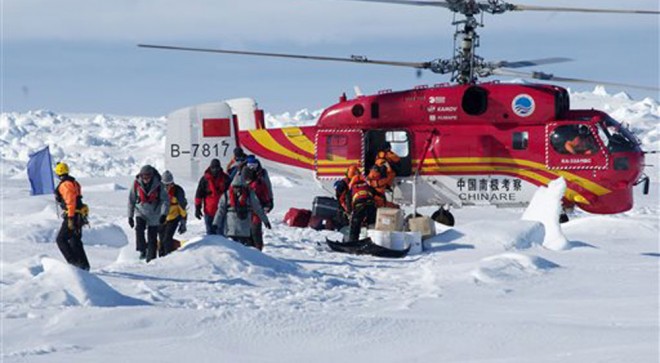
In this image provided by Australasian Antarctic Expedition, A Chinese helicopter arrives to rescue some of the 52 passengers trapped for more than a week on the icebound Russian research ship MV Akademik Shokalskiyin , Thursday, Jan. 2, 2014. AP
CANBERRA, Australia—An expedition of 52 scientists and tourists arrived in Australia on Wednesday, setting foot on dry land for the first time since they were rescued from a ship trapped in Antarctic sea ice three weeks ago.
Arguments continue on who will foot the bill for the extraordinary rescue operation that involved the United States, China, France and Australia.
Expedition leader Chris Turney told reporters who greeted them in the port city of Hobart where they ended the final leg of their rescue journey aboard an Australian icebreaker that it was still not clear who would pay for their rescue.
Turney, a professor of climate change at Sydney’s University of New South Wales, said lawyers and insurers were negotiating on the costs.
“I understand four nations helping is quite unusual. That’s not our call …. that’s beyond our control,” Turney said.
Turney’s expedition began on November 28. They had been retracing an expedition a century ago by Australian explorer Douglas Mawson and comparing scientific measurement made then and now when their Russian icebreaker Akademik Shokalskiy became trapped in ice-clogged Commonwealth Bay on Christmas Eve.
Australian, French and Chinese icebreakers were directed by Australia’s Rescue Coordination Centre to come to their rescue.
Under international conventions observed by most countries, ships’ crews are obliged to take part in such rescues and the owners carry the costs.
A helicopter from the Chinese icebreaker was able to ferry the passengers from the Russian ship to the Australian icebreaker Aurora Australis on January 2. The following day, the Chinese ship reported it too was stuck in ice.
United States Coast Guard heavy icebreaker, Polar Star, was sent from Sydney to rescue the Russian and Chinese ships, but both icebreakers were able to free themselves before the American cutter arrived.
The Australian ship continued its resupplying mission to Australia’s Antarctic base, Casey Station, before returning to its home port, Hobart.
Australian Antarctic Division director Tony Fleming estimated the cost of the rescue to the Australian government was between 1.8 million Australian dollars ($1.6 million) and AU$2.4 million ($2.1 million).
This did not include the costs to research projects scheduled to be conducted during the narrow window of the Antarctic summer. Some would have to be postponed because of the delay in scientific equipment and supplies arriving at Casey aboard the Australian ship.
Australia was discussing costs with both the insurers of the Russian ship and of the University of New South Wales which chartered it, Fleming said.
RELATED STORIES
Anxious wait for stranded Antarctic ship
Chinese ship used in Antarctic rescue stuck in ice

